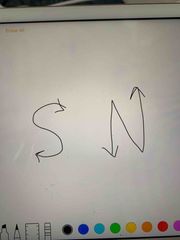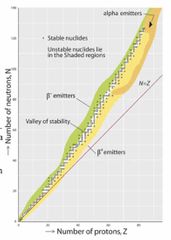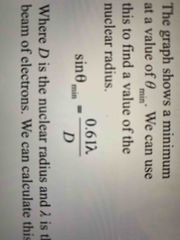![]()
![]()
![]()
Use LEFT and RIGHT arrow keys to navigate between flashcards;
Use UP and DOWN arrow keys to flip the card;
H to show hint;
A reads text to speech;
54 Cards in this Set
- Front
- Back
- 3rd side (hint)
|
Free Vibrations |
Free vibration is where a system is given an initial displacement and then allowed to vibrate/oscillate freely. |
|
|
|
Forced Vibration |
Forced vibration is where a driving force is continuously applied to make the system vibrate/oscillate. |
|
|
|
Driving frequency |
The thing that provides the driving force will be moving at a certain frequency. |
|
|
|
natural frequency, f0 |
The system will oscillate at a set frequency freely |
|
|
|
What Damping Forces do |
-oppose the motion of the oscillating body, they slow or stop simple harmonic motion from occurring. - act in the opposite direction to the velocity. |
|
|
|
Light Damping |
slowly reduces the amplitude of the oscillations, but keeps the time period almost constant. |
|
|
|
Heavy Damping |
allows the body to oscillate but brings it quickly to rest. |
|
|
|
Critical Damping |
brings the body back to the equilibrium point very quickly with out oscillation. |
|
|
|
Over Damping |
also prevent oscillation but makes the body take a longer time to reach equilibrium. |
|
|
|
Damping affects on Resonance |

Damping reduces the size of the oscillations at resonance. |
|
|
|
Radial Field |
The field lines end at the centre of a mass and tail back to infinity. We can see that they become more spread out the further from the mass we go. |
|
|
|
Uniform Fields |
The field lines are parallel in a uniform field. |
|
|
|
Why is Gravitational Potential Negative? |
The gravitational field is attractive so work is done by the field in moving the mass, meaning energy is given out. |
|
|
|
Current when Discharging a Capacitor |
There is initially a large current as the electrons leave the negative plate. As the number of electrons on the negative plate falls so does the size of the repulsive electrostatic force, this makes the current fall at a slower rate. When no more electrons move in the circuit the current drops to zero. |
|
|
|
Magnetic Field Lines -Direction they act North and south |

Magnetic field lines leave the North Pole of the magnet and enter the South Pole.. |
|
|
|
Lenz’S Law |
The direction of the e.m.f. induced in a conductor is such that it opposes the change producing it. |
|
|
|
Nuclear Model how it came about |
Rutherford used these results to make the following conclusions: Most of the mass must be gathered in one small volume – the nucleus. They can repel a fast moving alpha particle The nucleus must be positively charged. They repel positive alpha particles Most of the atom is empty space. Only 1 in 8000 alpha particles are deflected Negative electrons orbit the nucleus at a large distance from it. Negative charges are needed to keep the atom neutral
|
Observations and Conclusions |
|
|
Decay Constant |
Every radioactive isotope has its own probability that a nucleus will decay |
|
|
|
Activity |
The activity of a radioactive source is the number of decays that happen every second. |
|
|
|
Half Life |
The time it takes for the number of atoms in a sample to drop to half of its original sample or The time it takes for the activity of a substance to drop to half of its original activity |
|
|
|
N against Z Graph |

Back (Definition) Follows N=Z around Z=20, then curves to go through Z=80 N=120 β- emitters above the line, β+ emitters below the line and α at the top |
|
|
|
Electron Diffraction Equation |

Back (Definition) |
|
|
|
Mass deflect |
Disappearing Mass The mass of a nucleus is less than the mass of the protons and neutrons that it is made of. (mass of protons + mass of neutrons) – mass of nucleus = ∆m ∆m is the difference in the masses and is called the mass defect. |
|
|
|
Binding Energy |
As the protons and neutrons come together the strong nuclear force pulls them closer and they lose potential energy. Energy must be done against the s.n.f. to separate the nucleus into the nucleons it is made of. |
|
|
|
Critical Mass |
For a chain reaction to happen the mass of the fissionable material must be greater than a certain minimum value. |
|
|
|
Fuel Rod |
This is where nuclear fission reactions happen. They are made or Uranium and there are hundreds of them spread out in a grid like pattern. |
|
|
|
Enriched Uranium |
The Uranium that is used in fuel rods has a higher percentage of 235 |
|
|
|
Moderator |
The neutrons that are given out from nuclear fission are travelling too fast to cause another fission process. |
|
|
|
Thermal Neutrons |
Neutrons that are travelling slow enough to cause a fission process |
|
|
|
Coolant |
Heat is carried from the moderator to the heat exchanger by the coolant. The pressuriser and the pump move the hot coolant to the heat exchanger, here hot coolant touches pipes carrying cold water. Heat flows from hot coolant to cold water turning the water into steam and cooling the coolant. The steam then leaves the reactor (and will turn a turbine) as the coolant return to the reactor. |
|
|
|
Control rods |
For the reactor to transfer energy at a constant rate each nuclear fission reaction must lead to one more fission reaction. Since each reaction gives out two or more we must remove some of the extra neutrons. The control rods absorb neutrons, reducing the amount of nuclear fission processes occurring and making the power output constant. They can be lowered further into the fuel rods to absorb more neutrons and further reduce the amount of fission occurring. Some neutrons leave the reactor without interacting, some travel too fast while other are absorbed by U238 nuclei. If we need more neutrons we can raise the control rods. |
|
|
|
Control rods |
For the reactor to transfer energy at a constant rate each nuclear fission reaction must lead to one more fission reaction. Since each reaction gives out two or more we must remove some of the extra neutrons. The control rods absorb neutrons, reducing the amount of nuclear fission processes occurring and making the power output constant. They can be lowered further into the fuel rods to absorb more neutrons and further reduce the amount of fission occurring. Some neutrons leave the reactor without interacting, some travel too fast while other are absorbed by U238 nuclei. If we need more neutrons we can raise the control rods. |
|
|
|
Nuclear Reactor Safety |
-Fuel Used Using solids rather than liquids avoids the danger of leaks or spillages. They are inserted and removed from the reactor by remote controlled handling devices.
-Shielding - Emergency Shutdown |
|
|
|
Disposal of high level radioactive waste |
How do we get rid? The spent fuel rods are taken from the reactor and stored in cooling ponds with in the power station to allow most of the short-term radioactivity to die away. It is then transported to a processing plant. Here it is encased in steel containers and kept under water. The cladding is eventually removed and the fuel rods are separated into unused uranium and plutonium and highly radioactive waste. The uranium and plutonium is kept in sealed container for possible future use. The waste is converted into powder, fused into glass blocks, sealed in air-cooled containers for around 50 years before being stored deep underground in a stable rock formation. |
|
|
|
Disposal of high level radioactive waste |
How do we get rid? The spent fuel rods are taken from the reactor and stored in cooling ponds with in the power station to allow most of the short-term radioactivity to die away. It is then transported to a processing plant. Here it is encased in steel containers and kept under water. The cladding is eventually removed and the fuel rods are separated into unused uranium and plutonium and highly radioactive waste. The uranium and plutonium is kept in sealed container for possible future use. The waste is converted into powder, fused into glass blocks, sealed in air-cooled containers for around 50 years before being stored deep underground in a stable rock formation. |
|
|
|
Disposal of intermediate level Radioactive Waste |
How do we get rid? Sealed in steel drums that are encased in concrete and stored in buildings with reinforced concrete. Also stored deep underground in a suitable location that has a stable rock formation and low water flow. |
|
|
|
Disposal of low level radioactive waste |
How do we get rid? Sealed in metal drums and buried deep underground in a supervised repository. Treated cooling pond water is released into the environment. |
|
|
|
Temperature |
Temperature is a measure of the kinetic energies of the particles in the substance. |
|
|
|
Internal Energy |
The internal energy of a substance is due to the vibrations/movement energy of the particles (kinetic) and the energy due to the bonds holding them together (potential). |
|
|
|
Heat |
Heat is the flow of thermal energy and it flows from a high temperature to a low temperature. |
|
|
|
Nuclear Reactor Safety |
-Fuel Used Using solids rather than liquids avoids the danger of leaks or spillages. They are inserted and removed from the reactor by remote controlled handling devices. -Shielding - Emergency Shutdown |
|
|
|
Fusion |
Solid into liquid |
|
|
|
Vaporisation |
Liquid into gas |
|
|
|
Ideal Gas Assumptions |
1. There are a very large number of molecules (N) 2. Molecules have negligible volume compared to the container 3. The molecules show random motion (ranges of speeds and directions) 4. Newton’s Laws of Motion can be applied to the molecules 5. Collisions are elastic and happen quickly compared to the time between collisions 6. There are no intermolecular forces acting other than when they collide |
|
|
|
Specific Latent Heat |
-the energy required to change 1 kg of a substance from solid to liquid or liquid to gas -without a change in temperature. |
Q=mL |
|
|
When driving frequency is less than nature frequency what is the phase difference |
0 |
|
|
|
When driving frequency is less than nature frequency what is the phase difference |
0 |
|
|
|
What is the phase difference when driving frequency is equal to natural frequency |
π |
|
|
|
What is the phase difference when driving frequency is greater than natural frequency |
π/2 |
|
|
|
What happens when the driving frequency is lower than the natural frequency |
the oscillations have a low amplitude |
|
|
|
What happens when the driving frequency is the same as the natural frequency |
the amplitude increases massively, (maybe even exponentially). |
|
|
|
What happens when the driving frequency is higher than the natural frequency |
the amplitude of the oscillations decreases |
|
|
|
Coulomb’s law
|
force between two (point) charges is proportional to (product of)charges and inversely proportional to the square of their distance apart
|
|
|
|
What is the peak binding energy per nucleon? |
Peak 8.7 MeV per nucleon at 56 nucleons |
|

